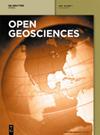Varying particle size selectivity of soil erosion along a cultivated catena
IF 1.3
4区 地球科学
Q3 GEOSCIENCES, MULTIDISCIPLINARY
引用次数: 0
Abstract
Sheet erosion is a complex multi-factor-dependent process with high spatial heterogeneity on hillslopes. Although the individual factors have been well studied, their aggregated effect on size-selective erosional processes is highly uncertain. Therefore, this study concentrates on the aggregate size distribution and effective particle size distribution (PSD) of the aggregates in the soil loss, collected from different simulated hillslope positions and surface conditions. These simulated hillslope positions combine moisture content from the extremely dry to the saturated with related slope positions of 2, 5, and 12% steepness and different surface roughness (tilled and crusted surfaces) modelled in a laboratory rainfall simulator. Using hierarchical cluster analysis, the PSD of the aggregates was separated into three groups based on the differences in the 59–116 µm range of the PSD histograms, namely, macro-aggregates, 50–250 µm sized micro-aggregates, and <50 µm sized fractions were classified into distinct groups, although some micro-aggregate samples were classified into the macro-aggregate group. PSDs from the 50–250 µm aggregate size fraction were clustered into a group of macro-aggregates if the PSD changed with time (during the rainfall event), notably on rough surfaces. The role of the specified size range in the classification is believed to be due to the parallel presence of aggregates and single particles in this range. As aggregates have a lower density than mineral particles, they tend to be enriched in soil loss under low-energy runoff conditions. Moreover, all samples in the <50 µm fraction clustered into the macro-aggregate group were eroded from the smooth/crusted surface, probably due to the presence of larger particles. The results indicate that the combined effect of erosional factors is not apparent, and the impact of the crust and extreme moisture content on the selectivity and size distribution of the sediment requires further investigation.土壤侵蚀对栽培鲶鱼的不同粒径选择性
片状侵蚀是一个复杂的多因素依赖过程,在山坡上具有高度的空间异质性。尽管已经对各个因素进行了深入研究,但它们对粒度选择性侵蚀过程的综合影响还很不确定。因此,本研究集中研究了从不同的模拟山坡位置和地表条件收集到的土壤流失中的集料粒度分布和集料的有效粒度分布(PSD)。这些模拟山坡位置结合了从极干到饱和的含水量,以及相关的坡度位置(2%、5% 和 12%)和实验室降雨模拟器模拟的不同表面粗糙度(耕地和板结表面)。利用分层聚类分析,根据 PSD 直方图 59-116 µm 范围内的差异,将聚集体的 PSD 分成三组,即宏观聚集体、50-250 µm 大小的微观聚集体和 50 µm 大小的馏分,尽管一些微观聚集体样本被归入宏观聚集体组。如果 PSD 随时间(降雨过程中)发生变化,尤其是在粗糙表面上发生变化,则 50-250 µm 骨料粒径部分的 PSD 被归入大骨料组。指定粒度范围在分类中的作用被认为是由于该范围内同时存在聚集体和单一颗粒。由于聚集体的密度比矿物颗粒低,因此在低能量径流条件下,聚集体往往会大量流失到土壤中。此外,所有被归入大型聚集体组的 50 µm 样品都从光滑/结壳表面被侵蚀,这可能是由于较大颗粒的存在。结果表明,侵蚀因素的综合影响并不明显,结壳和极端含水量对沉积物选择性和粒度分布的影响还需要进一步研究。
本文章由计算机程序翻译,如有差异,请以英文原文为准。
求助全文
约1分钟内获得全文
求助全文
来源期刊

Open Geosciences
GEOSCIENCES, MULTIDISCIPLINARY-
CiteScore
3.10
自引率
10.00%
发文量
63
审稿时长
15 weeks
期刊介绍:
Open Geosciences (formerly Central European Journal of Geosciences - CEJG) is an open access, peer-reviewed journal publishing original research results from all fields of Earth Sciences such as: Atmospheric Sciences, Geology, Geophysics, Geography, Oceanography and Hydrology, Glaciology, Speleology, Volcanology, Soil Science, Palaeoecology, Geotourism, Geoinformatics, Geostatistics.
 求助内容:
求助内容: 应助结果提醒方式:
应助结果提醒方式:


